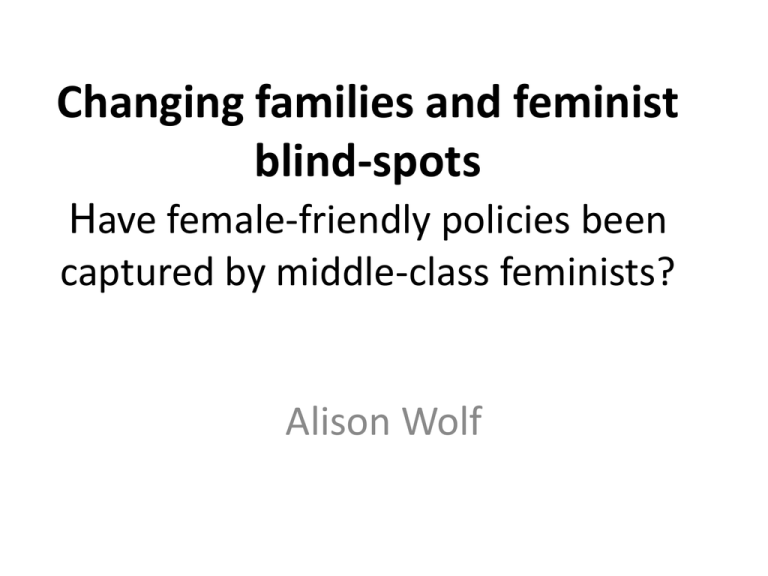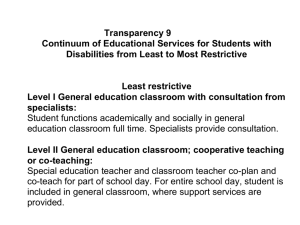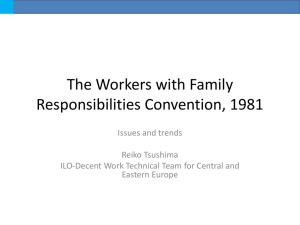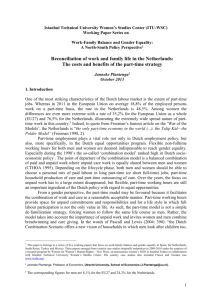
Changing families and feminist
blind-spots
Have female-friendly policies been
captured by middle-class feminists?
Alison Wolf
‘Feminism’ today
• Number 1 topics for self-identified feminist
columnists and commentators are sexual – daterape, campus rape, ‘gendered’ violence, ‘revenge
porn’
• Other major media topics are
– ‘pay gaps’ (interpreted as discriminatory)
– demands for female quotas in top jobs or all-female
lists
- campaign for’30%’ minimum board members to be
women pursued across developed world,
championed by top female executives
2014: a ‘watershed Rebecca Solnit’s
year’?
‘watershed’ events
And elsewhere
January
Dylan Farrow
Start of Israel-Gaza
testified that she
conflict.
was molested age 7
April
Silicon Valley
executive fired for
abuse conviction
Islamic State
mounts hugely
successful
offensive. Crimea
occupied
September
Videotape of
violence in a lift
Yazidi women
captured/sold.
Ukraine fighting
December
Canadian radio
host accused by 15
women
100,000s of Syrian
refugees in tent
camps. Pakistani
school atrocity
What ‘everyone’ (sic) was outraged by…
http://www.slate.com/articles/life/culturebox
/2014/12/the_year_of_outrage_2014_everyt
hing_you_were_angry_about_on_social_med
ia.html#part-8
’
A far cry from the progressive
breaking down of barriers which were
linked to gender as part of the liberal,
individualist revolution.
And far from reflecting a ‘post-liberal’
awareness of the continuing
importance of family, community, civil
society, ‘new’ feminism is the pursuit
of individual and elite self-interest.
Today it makes no more sense to talk
about ‘women’s interests’ as an
important, shared concept than it does
to talk about ‘men’s interests’.
Three huge social changes have made
the idea obsolete at best, and all too
often
perverse and harmful
Major changes
• Social change (1) Female labour market
participation
• Social change (2) Family structures
• Social change (3) Class differences, new and
old – the fragmentation of ‘sisterhood’
The new labour market: changing female
participation
• Major increases in female labour market
participation
• Rise most striking for married women, upper and
upper-middle income women, older women
• Also involves huge increase in part-time
employment
• Part-timers largely female – but part-time
employment is far more common for some
groups of women than others
• Labour force participation rates have
been increasing for women, falling for
men, over the last quarter-century
• Women are under, but close to, half
the entire labour force in developed
countries
• Overall participation rates for women
remain lower than for men
A similar picture at aggregate level…
Labour force participation 2009
90
80
70
60
50
Men 15-64
40
Women 15-64
30
20
10
0
Canada
France
Germany
Netherlands
UK
USA
The single most important
change?
Participation of MARRIED
women
This change came early in the US, somewhat later in
Western Europe
Trends in US female employment
70
60
50
40
% employed labor force (16+) who are female
30
employment rate for married women
20
10
0
1900 1910 1920 1930 1940 1950 1960 1970 1980 1990 2000 2010
(prov)
Female participation rates GB ( age 16-59)
80
70
60
50
% married
40
% single
30
20
10
0
1911
1921
1931
1941
1951
1961
1973
1981
1990
1998
Changing family structures
Marriage patterns
• Fewer marriages, more divorces
• More childless adults (men and women)
• More single-parent families, overwhelmingly
headed by women (both once-married and
never-married)
Child-bearing patterns
• Big decreases in average family size
• Big increase in number of women and men
who never have a child
• Very very few families with 3+ children
Decrease in family size is
universal
Other changes differ enormously by
class and education
Major differences between more and less
educated
• Very large increase in average age at marriage
and average age at first child for the highly
educated only
• Very large increase in the number who never
have a child, men and women, for the highly
educated only
• ‘Large’ (3+) families concentrated among the
very affluent and immigrant/some second
generation groups
Inter-generational links
• Families still the most important source of care
and support, not supplanted by welfare state
• For the very elderly, the infirm, the disabled,
family support critical. In some (many?)
countries, including the UK, state payments
increasingly concentrated – ‘minor’ disabilities
fall on families
• Grandparents play a major and increasingly
important role in child care, for both single and
two-parent families.
The death of sisterhood
Social change has generated major and
growing differences in the career and
family paths of more and less educated
women.
Educated women have jobs which are
the same as those of educated men, and
if they do not have children, their
salaries are the same.
Their work patterns are different, their
family patterns are different.
Male and female jobs: UK 1930
Men 1930
Women 1930
Professional/Technical
Professional/Technical
Clerical
Clerical
Sales
Sales
Manufacturing
Manufacturing
Service
Service
Agricultural
Agricultural
Male and female jobs UK 1999
Men 1999
Women 1999
Professional/Technical
Professional/Technical
Clerical
Clerical
Sales
Sales
Manufacturing
Manufacturing
Service
Service
Agricultural
Agricultural
% female: selected professions UK
60
50
40
30
1971
2009
20
10
0
Lawyers & judges
Teachers in higher Doctors and dentists
education
Scientists[1]
Economists,
statisticians, system
analysts, computer
programmers
For the top 15% of jobs, taken overall, gender
equality has arrived
% Class 1 jobs held by men and women: OECD 2000
Male
Female
Work patterns differ by education more than by gender
(and for childless graduates they don’t differ by gender at all)
Labour force participation 2008 by education age 25-64
100
90
80
70
60
Germany
50
Netherlands
40
UK
30
20
10
0
Males with less than upper
secondary
Males with tertiary
Females with less than upper
secondary
Females with tertiary
Huge growth internationally in female part-timers
% employed adults working part-time 2009
70
60
50
40
Men
Women
30
20
10
0
Australia
Denmark
France
Germany
Italy
Netherlands
UK
But not all women…
• Part-time work is more
likely for
• Less-educated
• Lower-paid
• Older
• With care responsibilities
• THESE GROUPS TAKE
LONGER BREAKS WHEN
THEY HAVE SMALL
CHILDREN
• Part-time work is less
likely for
• Highly educated
• Well paid
• Younger
• Professional jobs
• GRADUATE WOMEN TAKE
VERY SHORT BREAKS
FROM THE LABOUR
MARKET
Diverging lifestyles
• The less educated –
• The more educated -
• Work throughout most of
adult life
• Often work part-time to fit
in family demands
• More often single parents
• Work shifts
• Partner also often works
shifts
• ‘Job’ not career
• Work in female-dominated
sectors
• Work mostly full-time
• Take very short breaks for
children
• Are rarely single mothers at
birth, divorce less
• Work long but ‘normal’ days
• Career-oriented
• Work alongside men
• Employ domestic help
Large proportions of the non-graduate
workforce is in sectors where many jobs
are still either heavily female (and
traditionally so) or heavily male (and
traditionally so).
The stronger and larger the welfare
state, the more this is true.
This is why there is a ‘pay gap’
• Many desirable jobs are not available parttime. This is not, normally, prejudice (and if it
were, would be economically self-defeating).
• Many part-time jobs are in low-paid sectors
• Many part-time workers have had interrupted
employment histories
• NB AMONG part-time workers, women’s
average hourly pay is higher than men’s
Childcare and employment
• Care of small children is intrinsically labourintensive and expensive
• Private payments are post-tax
• Seen as major barrier to female employment
• Vocal demands for more state-supported, and
institutional provision
• UK has increased spending very rapidly, now
second-highest spender in OECD
But childcare patterns for UK 3 year olds show limits
Increases in subsidies for
childcare have either tiny or
indiscernible impact on
employment rates of mothers
of pre-schoolers.
So what do today’s leading feminists
most care about?
Inequality among women?
Policies and benefits that focus on
lower-paid women prioritising family?
Hardly…
The ’30%’ rule: a core demand
• Norway’s statutory requirement that publiclylisted companies should have at least 40%
female directors has been studied in depth.
• NO positive impact on company performance
(some evidence of the opposite)
• NO positive impact on wage rates or
promotion rates for other women in the
companies concerned
• Small group of very highly paid ‘golden skirts’
All-female lists
• Achieved in some political contexts
• Assumes that ‘being female’ gives you some
greater insight into ‘women’s needs’ in some
universal sense – but why should it?
• Actual voting patterns reflect the fact that it
almost certainly can’t and doesn’t
• There is NO EVIDENCE WHATSOEVER that women
are more likely to vote for a female candidate
because she is female
Sex, violence and ‘views’
• Human beings are obsessed with sex
• Human beings are obsessed with violence
• Social media are ‘quick-view’, headline driven
• How to get huge numbers of hits and views?
• Sex + violence. Sex + violence + feeling
superior (or victimised)
In conclusion
• Today’s self-proclaimed ‘new feminism’ has
little to do with today’s labour market or
today’s society, or with the acute problems
faced by many non-privileged women
• It has been captured by a combination of
highly-paid self-interest and commercial
acumen (dressed up as moral outrage): and by
a mindset which is that of an individualist,
career-oriented elite











